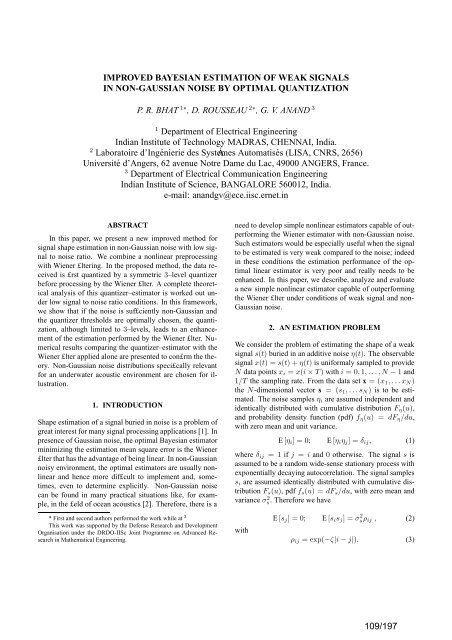a la physique de l'information - Lisa - Université d'Angers
a la physique de l'information - Lisa - Université d'Angers
a la physique de l'information - Lisa - Université d'Angers
Create successful ePaper yourself
Turn your PDF publications into a flip-book with our unique Google optimized e-Paper software.
IMPROVED BAYESIAN ESTIMATION OF WEAK SIGNALS<br />
IN NON-GAUSSIAN NOISE BY OPTIMAL QUANTIZATION<br />
P. R. BHAT 1∗ , D. ROUSSEAU 2∗ , G. V. ANAND 3<br />
1 Department of Electrical Engineering<br />
Indian Institute of Technology MADRAS, CHENNAI, India.<br />
2 Laboratoire d’Ingénierie <strong>de</strong>s SystÁemes Automatisés (LISA, CNRS, 2656)<br />
<strong>Université</strong> d’Angers, 62 avenue Notre Dame du Lac, 49000 ANGERS, France.<br />
3 Department of Electrical Communication Engineering<br />
Indian Institute of Science, BANGALORE 560012, India.<br />
e-mail: anandgv@ece.iisc.ernet.in<br />
ABSTRACT<br />
In this paper, we present a new improved method for<br />
signal shape estimation in non-Gaussian noise with low signal<br />
to noise ratio. We combine a nonlinear preprocessing<br />
with Wiener £ltering. In the proposed method, the data received<br />
is £rst quantized by a symmetric 3–level quantizer<br />
before processing by the Wiener £lter. A complete theoretical<br />
analysis of this quantizer–estimator is worked out un<strong>de</strong>r<br />
low signal to noise ratio conditions. In this framework,<br />
we show that if the noise is suf£ciently non-Gaussian and<br />
the quantizer thresholds are optimally chosen, the quantization,<br />
although limited to 3–levels, leads to an enhancement<br />
of the estimation performed by the Wiener £lter. Numerical<br />
results comparing the quantizer–estimator with the<br />
Wiener £lter applied alone are presented to con£rm the theory.<br />
Non-Gaussian noise distributions speci£cally relevant<br />
for an un<strong>de</strong>rwater acoustic environment are chosen for illustration.<br />
1. INTRODUCTION<br />
Shape estimation of a signal buried in noise is a problem of<br />
great interest for many signal processing applications [1]. In<br />
presence of Gaussian noise, the optimal Bayesian estimator<br />
minimizing the estimation mean square error is the Wiener<br />
£lter that has the advantage of being linear. In non-Gaussian<br />
noisy environment, the optimal estimators are usually nonlinear<br />
and hence more dif£cult to implement and, sometimes,<br />
even to <strong>de</strong>termine explicitly. Non-Gaussian noise<br />
can be found in many practical situations like, for example,<br />
in the £eld of ocean acoustics [2]. Therefore, there is a<br />
* First and second authors performed the work while at 3<br />
This work was supported by the Defense Research and Development<br />
Organisation un<strong>de</strong>r the DRDO-IISc Joint Programme on Advanced Research<br />
in Mathematical Engineering.<br />
need to <strong>de</strong>velop simple nonlinear estimators capable of outperforming<br />
the Wiener estimator with non-Gaussian noise.<br />
Such estimators would be especially useful when the signal<br />
to be estimated is very weak compared to the noise; in<strong>de</strong>ed<br />
in these conditions the estimation performance of the optimal<br />
linear estimator is very poor and really needs to be<br />
enhanced. In this paper, we <strong>de</strong>scribe, analyze and evaluate<br />
a new simple nonlinear estimator capable of outperforming<br />
the Wiener £lter un<strong>de</strong>r conditions of weak signal and non-<br />
Gaussian noise.<br />
2. AN ESTIMATION PROBLEM<br />
We consi<strong>de</strong>r the problem of estimating the shape of a weak<br />
signal s(t) buried in an additive noise η(t). The observable<br />
signal x(t) = s(t) + η(t) is uniformaly sampled to provi<strong>de</strong><br />
N data points xi = x(i × T ) with i = 0, 1, . . . , N − 1 and<br />
1/T the sampling rate. From the data set x = (x1, . . . xN )<br />
the N-dimensional vector s = (s1, . . . sN ) is to be estimated.<br />
The noise samples ηi are assumed in<strong>de</strong>pen<strong>de</strong>nt and<br />
i<strong>de</strong>ntically distributed with cumu<strong>la</strong>tive distribution Fη(u),<br />
and probability <strong>de</strong>nsity function (pdf) fη(u) = dFη/du,<br />
with zero mean and unit variance.<br />
E [ηi] = 0; E [ηiηj] = δij, (1)<br />
where δij = 1 if j = i and 0 otherwise. The signal s is<br />
assumed to be a random wi<strong>de</strong>-sense stationary process with<br />
exponentially <strong>de</strong>caying autocorre<strong>la</strong>tion. The signal samples<br />
si are assumed i<strong>de</strong>ntically distributed with cumu<strong>la</strong>tive distribution<br />
Fs(u), pdf fs(u) = dFs/du, with zero mean and<br />
variance σ 2 s. Therefore we have<br />
with<br />
E [sj] = 0; E [sisj] = σ 2 sρij , (2)<br />
ρij = exp(−ζ|i − j|). (3)<br />
109/197


